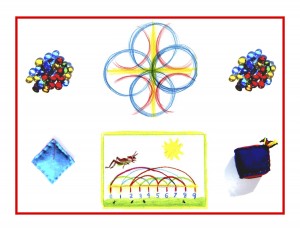Day 26
For one year, 365 days, this blog will address the Common Core Standards from the perspective of creating an alternate, ambient learning environment for math. Ambient is defined as “existing or present on all sides, an all-encompassing atmosphere.” And ambient music is defined as: “Quiet and relaxing with melodies that repeat many times.”
Why ambient? A math teaching style that’s whole and all encompassing, with themes that repeat many times through the years, is most likely to be effective and successful. Today’s blog will focus on the Kindergarten Common Core Math Standards and ambient counterparts that appeared in this blog on Days 10, 11, and 12. Note that the standards will be paraphrased and will appear in blue.
Day 26, 339 days to go. For the most part, this has been joyful work. I love the challenge of fitting creative activities into the most unlikely places, a self-styled “mother of invention” of sorts. I have worked with the Math By Hand project for some eight years now, and its growth has been phenomenal. For a small business, it’s been very successful. Typical of most small businesses though, the hours are many and long. Adding this daily blog posting to an already long day was/is a daunting prospect. And it’s been good, but I guess I’m in a bit of a cyber bubble, wondering if anyone’s out there. Faith does win the day however, and I do have that. So! On to Day 10.
Day 10
Operations and Algebraic Thinking K.OA
Understand addition as putting together and adding to, and subtraction as taking apart and taking from.
4. Use objects or drawings to find the number that makes 10 when added to any given number and record the answer with a drawing or equation.
Peter Rabbit and a rope can help with this understanding! The Beatrix Potter story could be told the day (or again and again for several days) before doing this with the child(ren). The rope and/or cloth as described in the post help to make the numbers and their relationship to the number 10 tangible. The story provides a lively background and a picture image for both learning how to tie the knots and showing what the number 10 and parts of it look like. The little drawing at the bottom of the post fills the standard’s requirement for recording the answer with a drawing. Several drawings could be made, with the number of holes varying between 1 and 10. After this activity has been introduced, it can be repeated with guidance. No formal teaching is necessary or desirable here, rather a spontaneous, joyful imitation should predominate within the free play segment.
Day 11
Operations and Algebraic Thinking K.OA
5. Fluently add and subtract within 5.
This post emphasizes the fact that testing and abstract learning have no place in the Kindergarten if the true beauty of math is to shine through, as a preventive of fears and phobias, engendering a life-long love of the subject. Objects are used to achieve fluency, and aspects of the 4 processes are introduced in a very rudimentary and concrete way. For the written portion, counting lines are again used instead of numbers, but the plus, minus, and equals signs are added to the mix. Using the picture stories suggested will insure that the first exposure to these abstract signs is manageable and age-appropriate.
Day 12
Number and Operations in Base Ten K.NBT
Work with numbers 11-19 to gain foundations for place value.
1. Compose and decompose (put together and take apart) numbers from 11-19 to show that the numbers 1-9 are added to 10 to make up the numbers 11-19.
Place value in the Math By Hand, Waldorf, and until recently, most educational theory and systems, has been reserved for a much later time. Mid to late second grade is an optimal time to teach this concept. Having Kindergartners do worksheets to learn place value is mistaken and even punishing. Forcing a child to go beyond his or her natural capacity is fruitless, frustrating, and can even be destructive of positive attitudes toward learning in future. So if place value comes in the Kindergarten at all, it must be in a very unconscious, playful mode. The jars and beans from the Day 4 post could be brought back as a refresher (or better, if they’re in the Math Corner, they’ve been played with since). As with the Peter Rabbit story, the Squirrel Nutkin one could be told the day (or several days) before, so the activity has a friendly, pictorial basis. Note that two kinds of counting happen here: 1-9 (each number in its own circled grouping) is said while drawing the acorns, then as the stems are added, 11-19 is said. One becomes eleven, two – twelve, three – thirteen, and so on. But do remember that all of it must be very casual and experiential, and directly referenced to real objects. Most importantly, at any sign of stress or difficulty, always revert to pure play.
Knowledge ensues in an environment dedicated to imaginative, creative knowing, where student and teacher alike surrender to the ensuing of that knowledge as a worthy goal. More Kindergarten tomorrow!












